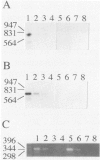Abstract
Ws/Ws rats have a small deletion at the tyrosine kinase domain of the c-kit gene, and practically no mast cells were detectable when the tissues were stained with alcian blue. Because alcian blue stains proteoglycans, there is a possibility that immature mast cells that do not contain a sufficient amount of proteoglycans are not detectable by this method. We examined this possibility by using other markers of mast cells. The histamine content in the skin of Ws/Ws rats was 0.3% that of control normal (+/+) rats. Because the number of alcian blue-positive mast cells in the skin of Ws/Ws rats was also 0.3% that of +/+ rats, histamine in the skin seemed to be concentrated to alcian blue-positive mast cells. Mast cells in the skin of +/+ rats express messenger RNA of Fc epsilon RI beta-subunit and c-kit protein. Because c-kit messenger RNA was normally expressed at least in the brain of Ws/Ws rats despite the small deletion, we examined the expression of Fc epsilon RI beta-subunit and c-kit messenger RNA in the skin and stomach of Ws/Ws rats by reverse transcriptase modification of polymerase chain reaction. Expression of either Fc epsilon RI beta-subunit or c-kit messenger RNA in the skin and stomach of Ws/Ws rats was estimated to be less than 1% that of +/+ rats. Moreover no Fc epsilon RI beta-subunit-expressing and no c-kit-expressing cells were detectable in the skin of Ws/Ws rats by in situ hybridization histochemistry. The present result suggests the absence of immature mast cells in tissues of Ws/Ws rats.
Full text
PDF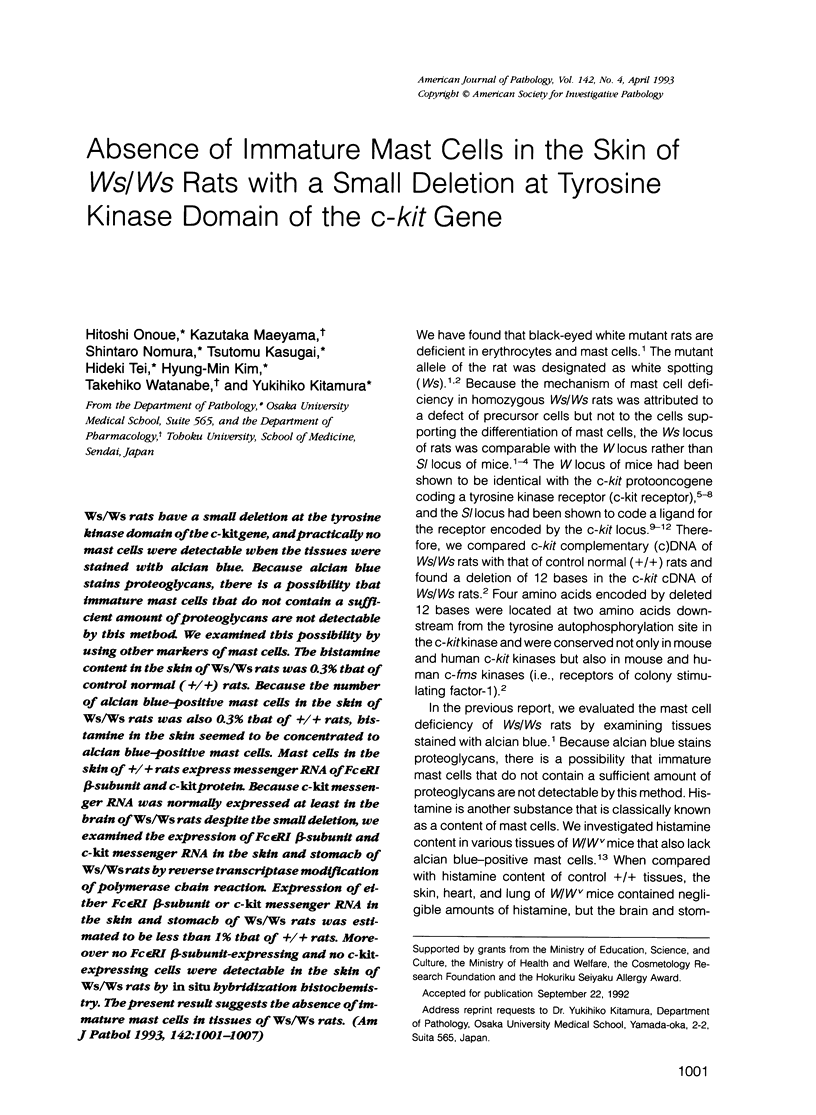
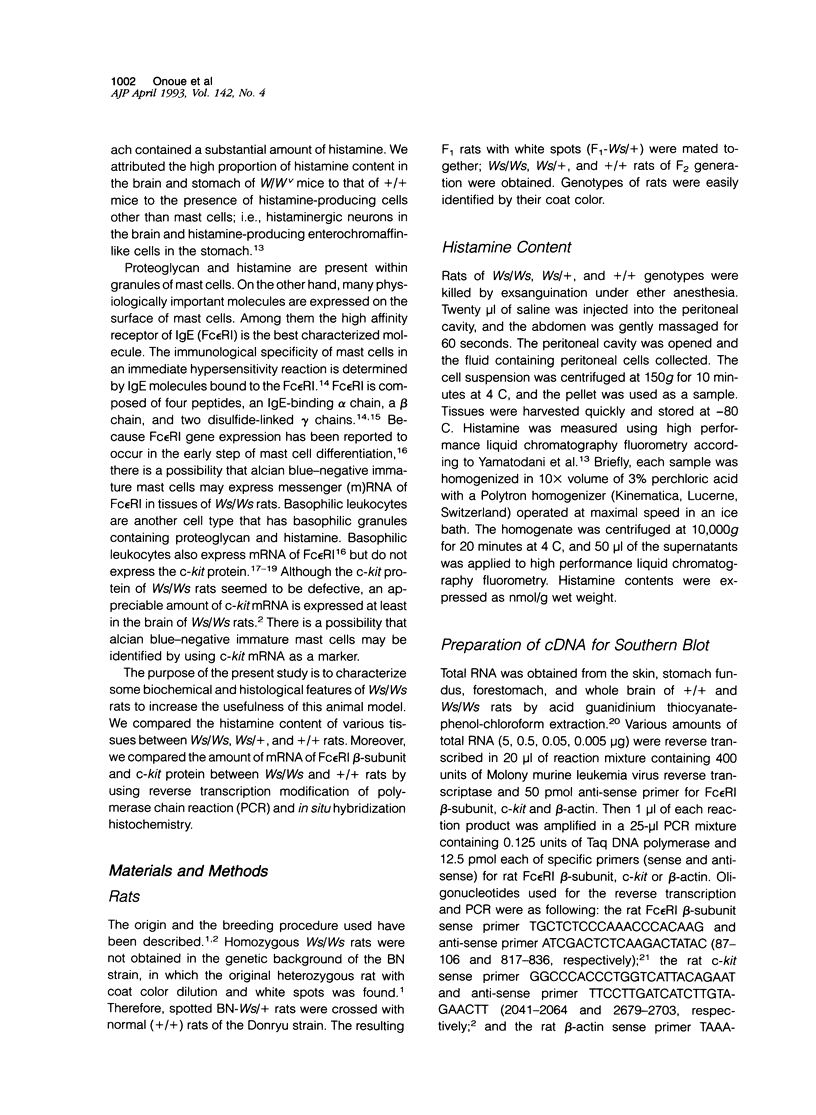
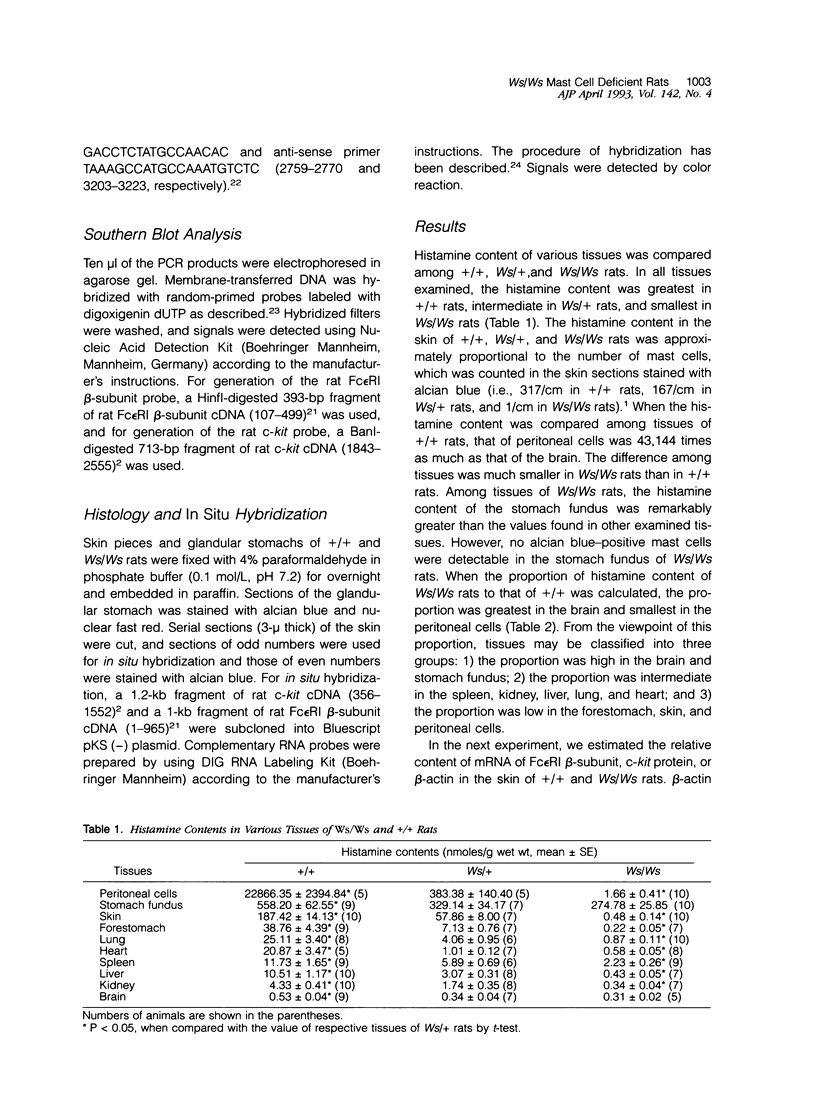
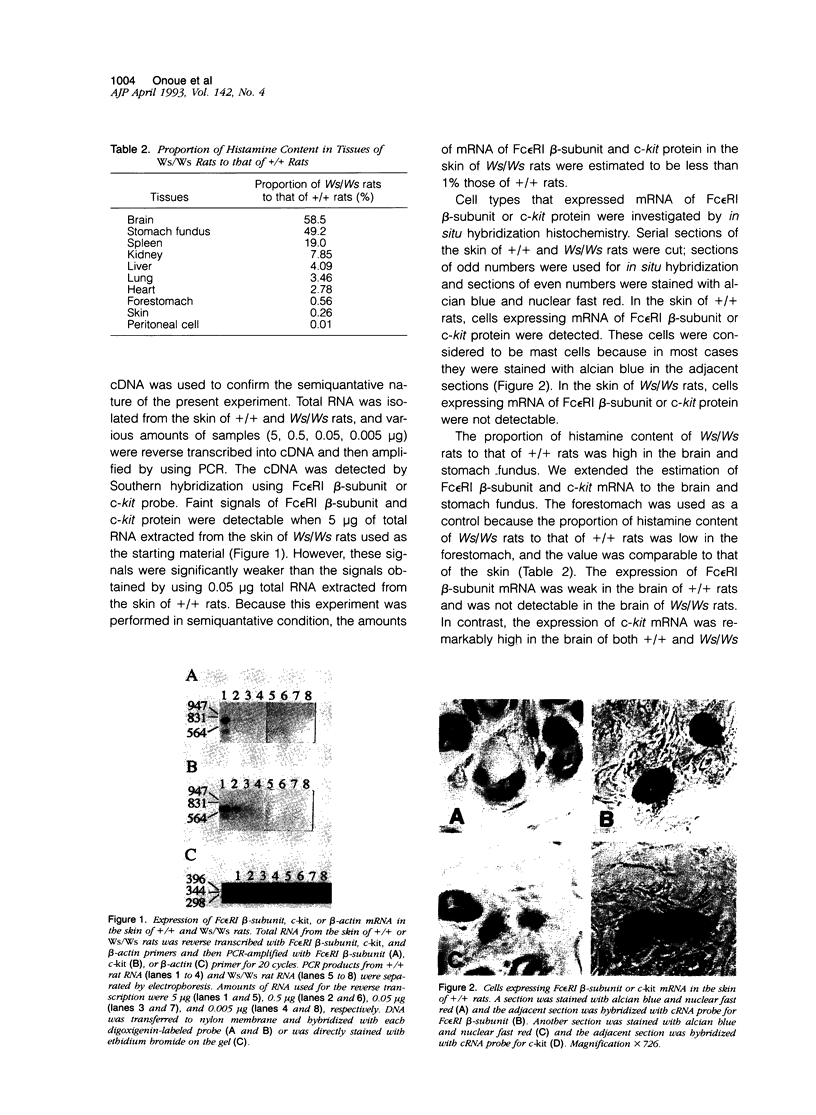
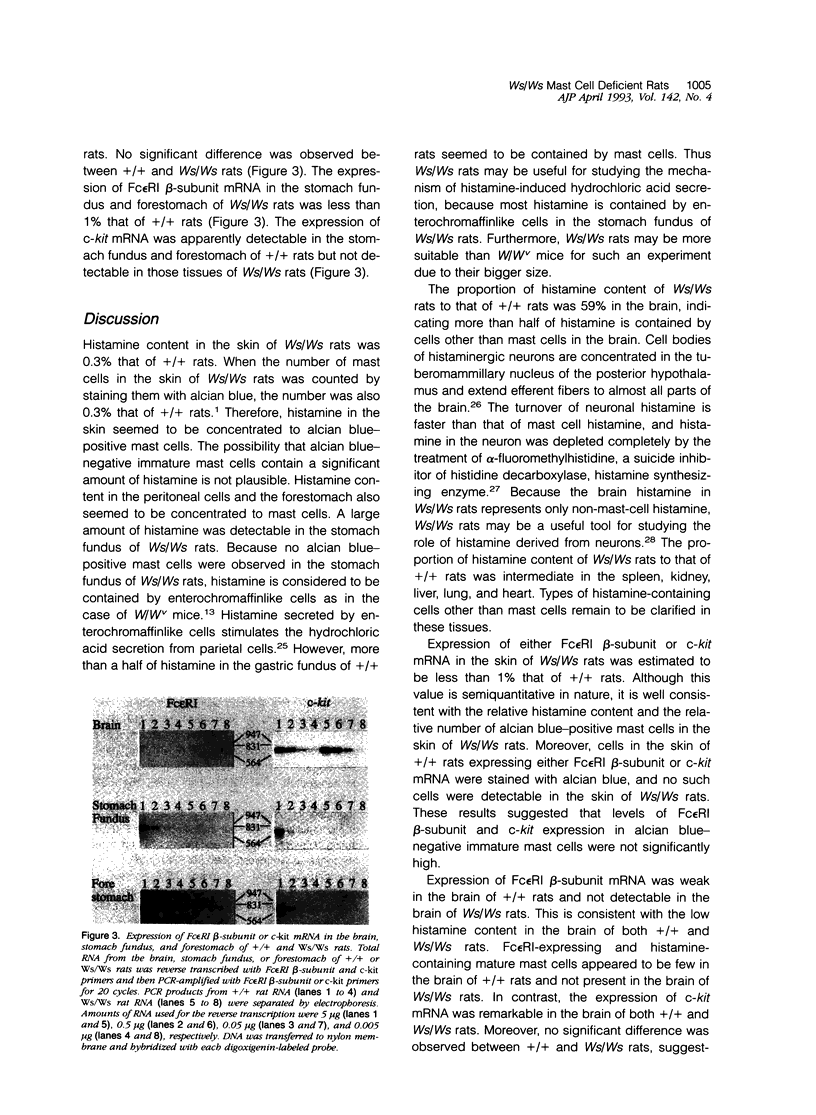

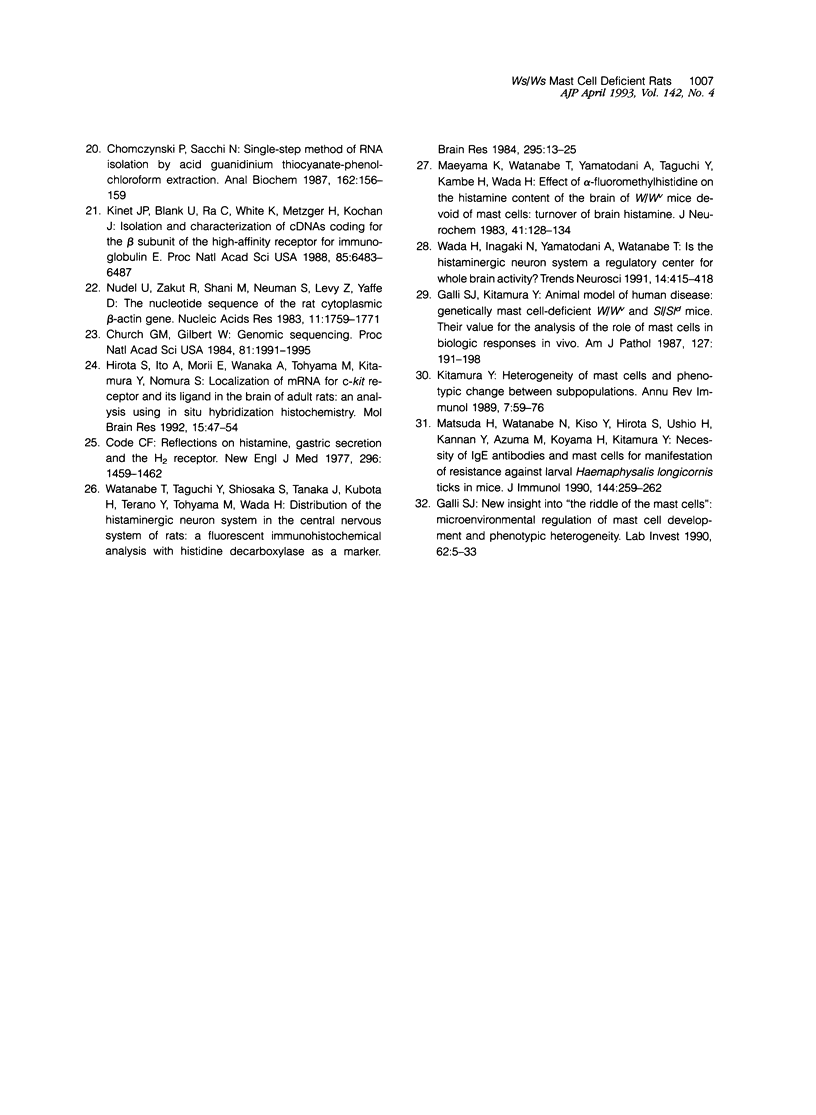
Images in this article
Selected References
These references are in PubMed. This may not be the complete list of references from this article.
- Chabot B., Stephenson D. A., Chapman V. M., Besmer P., Bernstein A. The proto-oncogene c-kit encoding a transmembrane tyrosine kinase receptor maps to the mouse W locus. Nature. 1988 Sep 1;335(6185):88–89. doi: 10.1038/335088a0. [DOI] [PubMed] [Google Scholar]
- Chomczynski P., Sacchi N. Single-step method of RNA isolation by acid guanidinium thiocyanate-phenol-chloroform extraction. Anal Biochem. 1987 Apr;162(1):156–159. doi: 10.1006/abio.1987.9999. [DOI] [PubMed] [Google Scholar]
- Church G. M., Gilbert W. Genomic sequencing. Proc Natl Acad Sci U S A. 1984 Apr;81(7):1991–1995. doi: 10.1073/pnas.81.7.1991. [DOI] [PMC free article] [PubMed] [Google Scholar]
- Code C. F. Reflections on histamine, gastric secretion and the H2 receptor. N Engl J Med. 1977 Jun 23;296(25):1459–1462. doi: 10.1056/NEJM197706232962510. [DOI] [PubMed] [Google Scholar]
- Flanagan J. G., Leder P. The kit ligand: a cell surface molecule altered in steel mutant fibroblasts. Cell. 1990 Oct 5;63(1):185–194. doi: 10.1016/0092-8674(90)90299-t. [DOI] [PubMed] [Google Scholar]
- Galli S. J., Kitamura Y. Genetically mast-cell-deficient W/Wv and Sl/Sld mice. Their value for the analysis of the roles of mast cells in biologic responses in vivo. Am J Pathol. 1987 Apr;127(1):191–198. [PMC free article] [PubMed] [Google Scholar]
- Galli S. J. New insights into "the riddle of the mast cells": microenvironmental regulation of mast cell development and phenotypic heterogeneity. Lab Invest. 1990 Jan;62(1):5–33. [PubMed] [Google Scholar]
- Geissler E. N., Ryan M. A., Housman D. E. The dominant-white spotting (W) locus of the mouse encodes the c-kit proto-oncogene. Cell. 1988 Oct 7;55(1):185–192. doi: 10.1016/0092-8674(88)90020-7. [DOI] [PubMed] [Google Scholar]
- Hirota S., Ito A., Morii E., Wanaka A., Tohyama M., Kitamura Y., Nomura S. Localization of mRNA for c-kit receptor and its ligand in the brain of adult rats: an analysis using in situ hybridization histochemistry. Brain Res Mol Brain Res. 1992 Sep;15(1-2):47–54. doi: 10.1016/0169-328x(92)90150-a. [DOI] [PubMed] [Google Scholar]
- Huang E., Nocka K., Beier D. R., Chu T. Y., Buck J., Lahm H. W., Wellner D., Leder P., Besmer P. The hematopoietic growth factor KL is encoded by the Sl locus and is the ligand of the c-kit receptor, the gene product of the W locus. Cell. 1990 Oct 5;63(1):225–233. doi: 10.1016/0092-8674(90)90303-v. [DOI] [PubMed] [Google Scholar]
- Kinet J. P., Blank U., Ra C., White K., Metzger H., Kochan J. Isolation and characterization of cDNAs coding for the beta subunit of the high-affinity receptor for immunoglobulin E. Proc Natl Acad Sci U S A. 1988 Sep;85(17):6483–6487. doi: 10.1073/pnas.85.17.6483. [DOI] [PMC free article] [PubMed] [Google Scholar]
- Kitamura Y., Go S. Decreased production of mast cells in S1/S1d anemic mice. Blood. 1979 Mar;53(3):492–497. [PubMed] [Google Scholar]
- Kitamura Y., Go S., Hatanaka K. Decrease of mast cells in W/Wv mice and their increase by bone marrow transplantation. Blood. 1978 Aug;52(2):447–452. [PubMed] [Google Scholar]
- Kitamura Y. Heterogeneity of mast cells and phenotypic change between subpopulations. Annu Rev Immunol. 1989;7:59–76. doi: 10.1146/annurev.iy.07.040189.000423. [DOI] [PubMed] [Google Scholar]
- Lerner N. B., Nocka K. H., Cole S. R., Qiu F. H., Strife A., Ashman L. K., Besmer P. Monoclonal antibody YB5.B8 identifies the human c-kit protein product. Blood. 1991 May 1;77(9):1876–1883. [PubMed] [Google Scholar]
- Maeyama K., Watanabe T., Yamatodani A., Taguchi Y., Kambe H., Wada H. Effect of alpha-fluoromethylhistidine on the histamine content of the brain of W/Wv mice devoid of mast cells: turnover of brain histamine. J Neurochem. 1983 Jul;41(1):128–134. doi: 10.1111/j.1471-4159.1983.tb11823.x. [DOI] [PubMed] [Google Scholar]
- Matsuda H., Watanabe N., Kiso Y., Hirota S., Ushio H., Kannan Y., Azuma M., Koyama H., Kitamura Y. Necessity of IgE antibodies and mast cells for manifestation of resistance against larval Haemaphysalis longicornis ticks in mice. J Immunol. 1990 Jan 1;144(1):259–262. [PubMed] [Google Scholar]
- Mayrhofer G., Gadd S. J., Spargo L. D., Ashman L. K. Specificity of a mouse monoclonal antibody raised against acute myeloid leukaemia cells for mast cells in human mucosal and connective tissues. Immunol Cell Biol. 1987 Jun;65(Pt 3):241–250. doi: 10.1038/icb.1987.27. [DOI] [PubMed] [Google Scholar]
- Metzger H., Alcaraz G., Hohman R., Kinet J. P., Pribluda V., Quarto R. The receptor with high affinity for immunoglobulin E. Annu Rev Immunol. 1986;4:419–470. doi: 10.1146/annurev.iy.04.040186.002223. [DOI] [PubMed] [Google Scholar]
- Niwa Y., Kasugai T., Ohno K., Morimoto M., Yamazaki M., Dohmae K., Nishimune Y., Kondo K., Kitamura Y. Anemia and mast cell depletion in mutant rats that are homozygous at "white spotting (Ws)" locus. Blood. 1991 Oct 15;78(8):1936–1941. [PubMed] [Google Scholar]
- Nudel U., Zakut R., Shani M., Neuman S., Levy Z., Yaffe D. The nucleotide sequence of the rat cytoplasmic beta-actin gene. Nucleic Acids Res. 1983 Mar 25;11(6):1759–1771. doi: 10.1093/nar/11.6.1759. [DOI] [PMC free article] [PubMed] [Google Scholar]
- Qiu F. H., Ray P., Brown K., Barker P. E., Jhanwar S., Ruddle F. H., Besmer P. Primary structure of c-kit: relationship with the CSF-1/PDGF receptor kinase family--oncogenic activation of v-kit involves deletion of extracellular domain and C terminus. EMBO J. 1988 Apr;7(4):1003–1011. doi: 10.1002/j.1460-2075.1988.tb02907.x. [DOI] [PMC free article] [PubMed] [Google Scholar]
- Ra C., Jouvin M. H., Kinet J. P. Complete structure of the mouse mast cell receptor for IgE (Fc epsilon RI) and surface expression of chimeric receptors (rat-mouse-human) on transfected cells. J Biol Chem. 1989 Sep 15;264(26):15323–15327. [PubMed] [Google Scholar]
- Thompson H. L., Metcalfe D. D., Kinet J. P. Early expression of high-affinity receptor for immunoglobulin E (Fc epsilon RI) during differentiation of mouse mast cells and human basophils. J Clin Invest. 1990 Apr;85(4):1227–1233. doi: 10.1172/JCI114557. [DOI] [PMC free article] [PubMed] [Google Scholar]
- Tsujimura T., Hirota S., Nomura S., Niwa Y., Yamazaki M., Tono T., Morii E., Kim H. M., Kondo K., Nishimune Y. Characterization of Ws mutant allele of rats: a 12-base deletion in tyrosine kinase domain of c-kit gene. Blood. 1991 Oct 15;78(8):1942–1946. [PubMed] [Google Scholar]
- Wada H., Inagaki N., Yamatodani A., Watanabe T. Is the histaminergic neuron system a regulatory center for whole-brain activity? Trends Neurosci. 1991 Sep;14(9):415–418. doi: 10.1016/0166-2236(91)90034-r. [DOI] [PubMed] [Google Scholar]
- Watanabe T., Taguchi Y., Shiosaka S., Tanaka J., Kubota H., Terano Y., Tohyama M., Wada H. Distribution of the histaminergic neuron system in the central nervous system of rats; a fluorescent immunohistochemical analysis with histidine decarboxylase as a marker. Brain Res. 1984 Mar 12;295(1):13–25. doi: 10.1016/0006-8993(84)90811-4. [DOI] [PubMed] [Google Scholar]
- Williams D. E., Eisenman J., Baird A., Rauch C., Van Ness K., March C. J., Park L. S., Martin U., Mochizuki D. Y., Boswell H. S. Identification of a ligand for the c-kit proto-oncogene. Cell. 1990 Oct 5;63(1):167–174. doi: 10.1016/0092-8674(90)90297-r. [DOI] [PubMed] [Google Scholar]
- Yamatodani A., Maeyama K., Watanabe T., Wada H., Kitamura Y. Tissue distribution of histamine in a mutant mouse deficient in mast cells: clear evidence for the presence of non-mast-cell histamine. Biochem Pharmacol. 1982 Feb 1;31(3):305–309. doi: 10.1016/0006-2952(82)90175-7. [DOI] [PubMed] [Google Scholar]
- Yarden Y., Kuang W. J., Yang-Feng T., Coussens L., Munemitsu S., Dull T. J., Chen E., Schlessinger J., Francke U., Ullrich A. Human proto-oncogene c-kit: a new cell surface receptor tyrosine kinase for an unidentified ligand. EMBO J. 1987 Nov;6(11):3341–3351. doi: 10.1002/j.1460-2075.1987.tb02655.x. [DOI] [PMC free article] [PubMed] [Google Scholar]
- Zsebo K. M., Williams D. A., Geissler E. N., Broudy V. C., Martin F. H., Atkins H. L., Hsu R. Y., Birkett N. C., Okino K. H., Murdock D. C. Stem cell factor is encoded at the Sl locus of the mouse and is the ligand for the c-kit tyrosine kinase receptor. Cell. 1990 Oct 5;63(1):213–224. doi: 10.1016/0092-8674(90)90302-u. [DOI] [PubMed] [Google Scholar]



